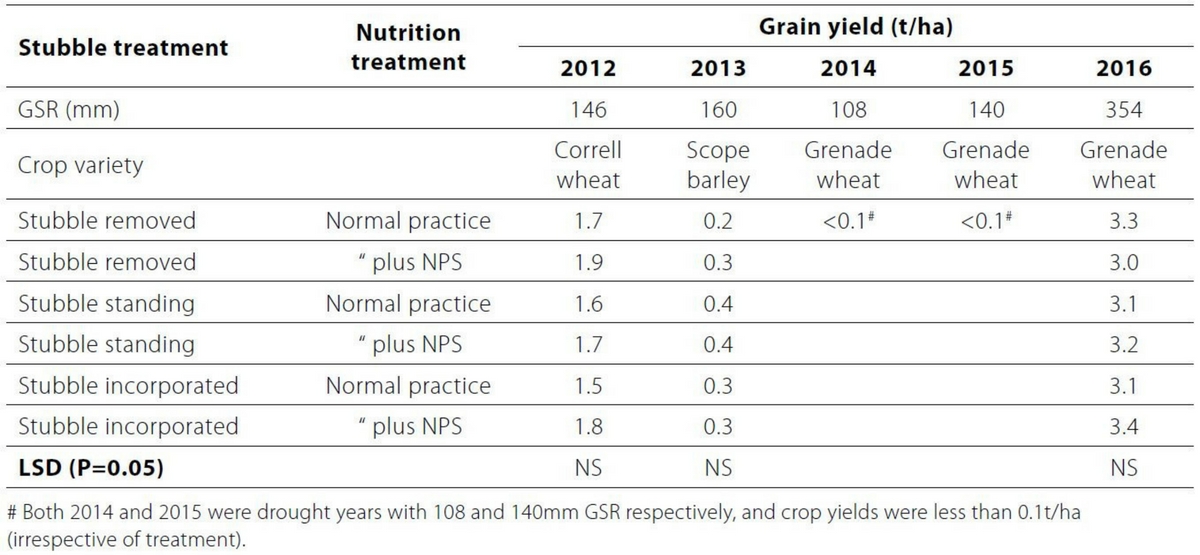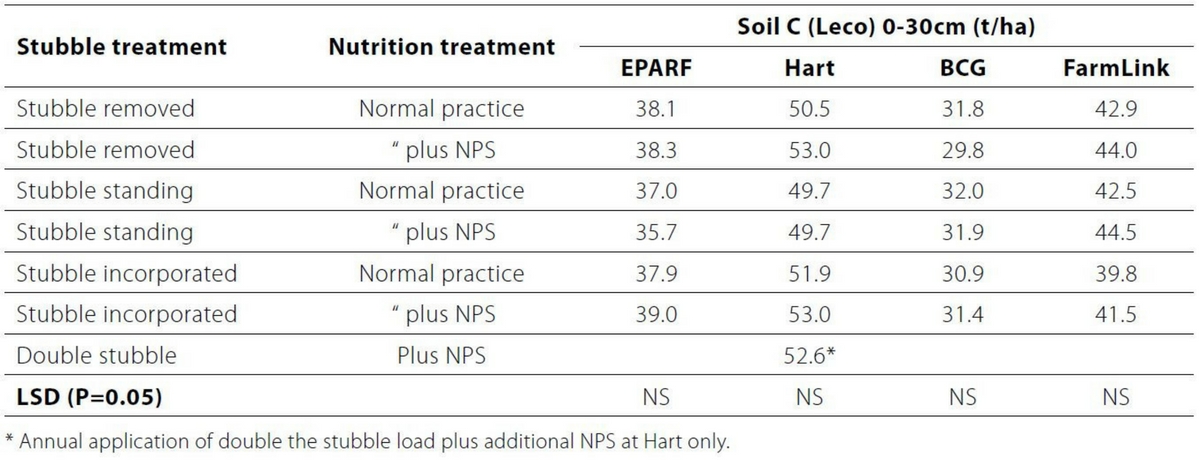Take home messages
- After three and five years of treatments no increase in soil organic carbon could be demonstrated at any of the eight sites tested.
- It was demonstrated that soil organic carbon is very unlikely to increase with current farming practices. But we do know that no-till and stubble retention protects the soil from wind and water erosion and over a longer time-frame the soil organic carbon levels may increase.
Background
Soil organic matter has physical, chemical and biological functions in the soil. Increasing soil organic matter levels may improve the capacity of these functions in the soil, thereby improving the soils’ resilience to degradation and possibly improving the soils productivity. Increasing soil organic matter also sequesters atmospheric CO2 which acts as a sink for greenhouse gas emissions.
Increasing soil organic matter on broadacre farms in the Australian wheat-sheep zone has been very difficult to achieve with long term trials showing little or no increase in soil organic carbon regardless of management practices imposed. Recent research undertaken by CSIRO at a medium to high rainfall site in NSW has demonstrated that increasing soil organic carbon was possible if residues are pulverised and incorporated with a rotary cultivator, together with an application of sufficient fertiliser nutrients (nitrogen (N), phosphorus (P) and sulphur (S)) to enhance soil biological activity to break down the crop residues into soil organic matter (Kirkby et al. 2016). This innovation was adapted to broadacre farming methods and tested over a three and five year cropping rotation with grower groups at eight sites across the southern grain belt.
Soil organic matter consists of three fractions – Particulate (POC), Humus (HOC) and Resistant (ROC). The three fractions have different physical, chemical and biological functions in soils. The proportions of the three fractions as components of the soil organic matter were measured and are reported in these results.
| POC: | Reducing soil crusting and improving infiltration |
| Improving soil friability | |
| Lowering the soil bulk density | |
| Increasing Plant Available Water (note – POC has a small effect on the drained upper limit of the soil but because clay loam soils in dry environments such as the southern Mallee are rarely at drained upper limit, this benefit is only minor) | |
| Storage and cycling of nutrients | |
| Food source for soil micro-organisms. | |
| HOC: | Improving soil friability |
| Storage and cycling of nutrients | |
| Soil pH buffer (reducing acidification) | |
| Improving the cation exchange capacity (CEC) | |
| Food source for soil micro-organisms | |
| Mineralisation of ammonium and nitrate (plant available N). | |
| ROC: | Binding detrimental ions (such as aluminium), |
| Some effect on the CEC. |
It is clear that if soil organic carbon levels can be increased, the benefits for improving the soil physical, chemical and biological condition would be significant.
Aim
To determine whether soil organic carbon levels can be increased by retaining stubble and applying additional nutrients to enhance soil biological activity to breakdown the stubble into soil organic matter.
Method
Eight sites were established in South East (SE) Australia at grower group locations. The five year sites were located at Minnipa – EPARF, Hart Field Site, Birchip – BCG and Temora – FarmLink. The three year sites were located at Winchelsea (Vic) and Cressy (Tasmania) – SFS, Condobolin – CWFS and Ouyen – MSF.
The trial compared stubble retention versus stubble removal, with the application of additional fertiliser nutrients to aid the breakdown of stubbles into soil organic matter over a cropping rotation. Each season the stubble load of the previous crop was determined, and additional nutrients were applied to match the given stubble load as a treatment to enhance the breakdown of stubble into soil organic matter.
Soil microbes use stubble as a food source and convert stubble into humus. Stubble is carbon rich relative to the other essential nutrients required by microbes and additional nutrients are required by the soil microbes to convert stubble into humus. The amount of N, P and S required by the microbial population to break down stubble into humus is worked out from:
- 1 tonne of carbon as humus contains 80kg N, 20kg P and 14kg S.
- 1 tonne of wheat stubble contains 450kg carbon, of which 70% is lost to the atmosphere (hence 135kg carbon is retained for every tonne of stubble).
- For the soil microbes to convert this amount of stubble carbon into humus requires 10.8kg N, 2.7kg P and 1.9kg S.
- 1 tonne of wheat stubble already contains 5kg N, 0.5kg P and 1kg S.
- Hence for every tonne of wheat stubble an additional 5.8kg N, 2.2kg P and 0.9kg S is required to enable the soil microbes to break down stubble into humus.
The trial was established in 2012 at one of the BCG long term trial sites 9km west of Birchip. Treatments were replicated four times and consisted of:
- Stubble: (i) retained and left standing; (ii) cultivated and incorporated prior to sowing; (iii) removed prior to sowing.
- Nutrients: (i) normal application of N, P and S to optimise production; (ii) additional nutrients applied at sowing to enhance microbial activity to breakdown stubble into soil organic matter. (Note – the Yield Prophet® model was used to optimise N requirements in-crop).
The trial ran for five cropping seasons (2012 to 2016). At the end of the trial, in March 2017, all treatment plots were soil sampled to 30cm depth with three replicate cores taken in each plot. Each core was divided into 0-10 and 10-30cm sections. Each sample was air dried and analysed for bulk density, total soil organic carbon (Leco) and the fractions of soil organic matter –POC, HOC and ROC using MIR. Treatment crop yields were recorded.
Results and interpretation
Trial rotation and crop yield
Over the five-year trial there were no differences in yield between treatments (Table 1). This result implies that the additional nutrients applied as a treatment were not used by the crop for yield but were available to the soil microbes for potential stubble breakdown into humus.
Table 1. Crop rotation and yield over five years of treatments (2012 to 2016) at Birchip.
At the other three sites with a five year rotation (Hart, Minnipa and Temora) there were also no differences in crop yield between treatments.
Change in soil organic carbon after five years of treatments
The average soil organic carbon content at Birchip was 1.3% in the topsoil (0-10cm) and 0.7% in the subsoil (10-30cm). After five years of trial work there was no difference in total soil organic carbon (t/ha, 0-30cm) at Birchip (Table 2) nor at the other three trial sites. (Note: in this study soil organic carbon was measured with the Leco technique, these values are generally 20% higher than the more traditionally used analysis for soil organic carbon with the Walkley Black technique).
Table 2. Soil organic carbon stock (t/ha, 0-30cm) after five years of treatments (2012 to 2016) at four trial sites.
At the Hart site an extra treatment was included – each year the stubble load was doubled and the required additional nutrients were applied. This treatment did not result in higher soil organic carbon levels (Table 2) after five years of experimentation.
Soil organic carbon fractions
At Birchip and the other three trial sites the treatments did not result in changes in the soil organic matter fractions. After five years of treatment applications the soil organic carbon fraction proportions were: 10% POC, 67% HOC and 23% ROC.
Commercial practice
In the SE Australian low to medium rainfall zones it is difficult to increase soil organic carbon levels using current cropping techniques, even if additional nutrients are applied to enhance soil microbial activity for the breakdown of stubble into soil organic matter. The previous research undertaken in southern NSW where significant increases in soil organic carbon were measured (Kirkby et al. 2016), included pulverising the residues with a flail mulcher followed by incorporation with a rotary cultivator. This treatment was not applied in these trials because it was regarded unlikely that farmers could be persuaded to pulverise stubbles and cultivate the soil, increasing the risk of soil erosion in low rainfall environments to see a potential increase in soil organic carbon.
At all eight sites that the trial was carried out, the result was the same – an increase in soil organic carbon could not be demonstrated with the treatments outlined in this paper.
Soil organic carbon is unlikely to increase with current cropping practices. However, we do know that no-till and stubble retention protects the soil from wind and water erosion and over a longer timeframe soil organic carbon levels may increase. Based on these results it is likely that any potential increases in soil organic carbon will be small.
References
Acknowledgements
The soil organic carbon trial and extension work was funded by GRDC (project code CRF00002).


